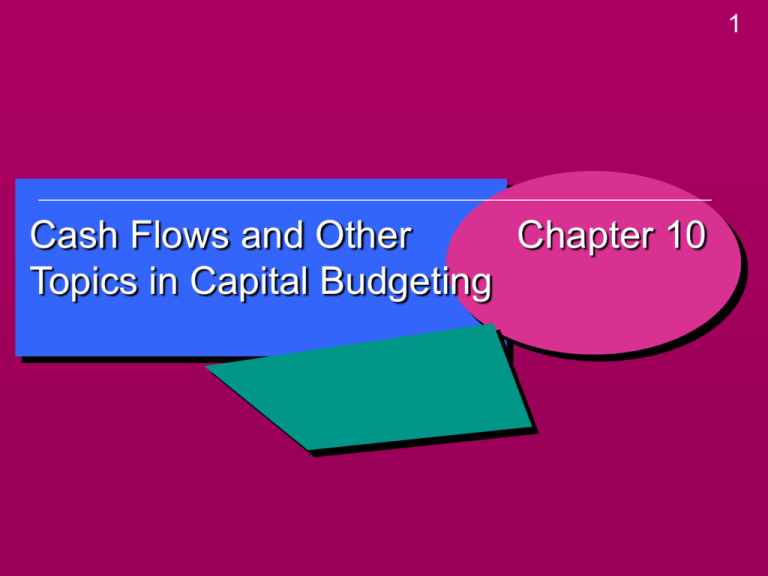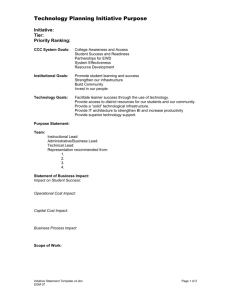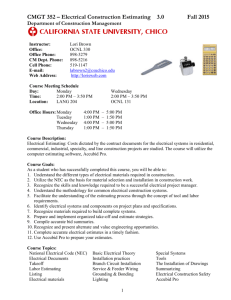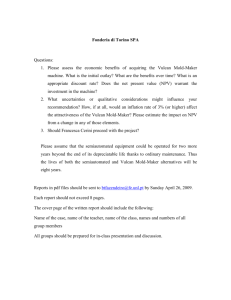Chapter 10
advertisement

1 Cash Flows and Other Chapter 10 Topics in Capital Budgeting Cash Flows in General Measure Incremental Cash Flows Measure cash flows that change if a project is undertaken Sunk cost is irrelevant Opportunity cost is relevant Do not include allocation of existing overhead Do subtract lost sales of other products Include cost savings as a positive cash flow. 3 Cash Flows in General New Project vs. Replacement Project New project – simply addition to company Replacement – replace and existing old machine or plant. Financing costs - Interest and Dividend payments. are not considered operating cash flows. Financing cost are used to discount the cash flows to find NPV,etc. Only include CASH inflows and outflows. 4 5 Estimating Cash Flows Three Types of Cash Flows Initial Outlay 0 Initial Outlay 1 2 3 N 6 Estimating Cash Flows Three Types of Cash Flows Initial Outlay Operating (Differential) Cash Flows 0 Initial Outlay 1 2 Operating Cash Flows 3 N 7 Estimating Cash Flows Three Types of Cash Flows Initial Outlay Operating (Differential) Cash Flows Terminal Cash Flow 0 Initial Outlay 1 2 Operating Cash Flows 3 N Terminal Cash Flow Estimating Cash Flows Initial Outlay Cost of Assets Installation and Shipping Non-Expense Outlays (i.e. Working Capital) Expense Outlays after tax (i.e. Training Expenses) 8 Estimating Cash Flows Initial Outlay Cost of Assets Installation and Shipping Non-Expense Outlays (i.e. Working Capital) Expense Outlays after tax (i.e. Training Expenses) Only for Replacement Projects Sale of Old Machine 9 Estimating Cash Flows Initial Outlay Cost of Assets Installation and Shipping Non-Expense Outlays (i.e. Working Capital) Expense Outlays after tax (i.e. Training Expenses) Only for Replacement Projects Sale of Old Machine Taxes on Machine 10 Estimating Cash Flows 11 Initial Outlay Example: Gasperini Corp. is considering replacing their old production machine with a new one. The cost of the new machine is $48,000; installation and delivery cost $2,000. Working Capital requirements on the new machine are $3,000 immediately, and training costs amount to $4,000. The old machine can be sold for $10,000; its book value is zero. Gasperini has a marginal tax rate of 40%. Estimating Cash Flows Initial Outlay Cost of Machine +48,000 12 Estimating Cash Flows Initial Outlay Cost of Machine Installation & Shipping +48,000 2,000 13 Estimating Cash Flows Initial Outlay Cost of Machine Installation & Shipping Working Capital +48,000 2,000 3,000 14 Estimating Cash Flows 15 Initial Outlay Cost of Machine Installation & Shipping Working Capital Training (after tax) +48,000 2,000 3,000 2,400 4,000(1-0.40) 16 Estimating Cash Flows Initial Outlay Cost of Machine Installation & Shipping Working Capital Training (after tax) +48,000 2,000 3,000 2,400 +55,400 Less: Sale of Old Machine 17 Estimating Cash Flows Initial Outlay Cost of Machine Installation & Shipping Working Capital Training (after tax) +48,000 2,000 3,000 2,400 +55,400 Less: Sale of Old Machine Salvage Value 10,000 18 Estimating Cash Flows Initial Outlay Cost of Machine Installation & Shipping Working Capital Training (after tax) +48,000 2,000 3,000 2,400 +55,400 Less: Sale of Old Machine Salvage Value –Taxes 10,000 – 4,000 Tax rate x (Salvage Value-Book Value) .4(10,000 – 0) 19 Estimating Cash Flows Initial Outlay Cost of Machine Installation & Shipping Working Capital Training (after tax) +48,000 2,000 3,000 2,400 +55,400 Less: Sale of Old Machine Salvage Value –Taxes 10,000 – 4,000 – 6,000 20 Estimating Cash Flows Initial Outlay Cost of Machine Installation & Shipping Working Capital Training (after tax) +48,000 2,000 3,000 2,400 +55,400 Less: Sale of Old Machine Salvage Value –Taxes Initial Outlay 10,000 – 4,000 – 6,000 +49,400 21 Estimating Cash Flows Initial Outlay Cost of Machine Installation & Shipping Working Capital Training (after tax) +48,000 2,000 3,000 2,400 +55,400 Less: Sale of Old Machine Salvage Value –Taxes 10,000 – 4,000 – 6,000 +49,400 Initial Outlay 0 -49,400 1 2 3 4 5 Estimating Cash Flows 22 Terminal Cash Flow Example: Gasperini Corp. is considering replacing their old production machine with a new one. The cost of the new machine is $48,000; installation and delivery cost $2,000. Working Capital requirements on the new machine are $3,000 immediately, and training costs amount to $4,000. The old machine can be sold for $10,000; its book value is zero. Gasperini has a marginal tax rate of 40%. The new machine Gasperini Corp is considering buying will increase revenues by $5,000/yr and decrease costs by $8,000/ yr. They expect to use the machine for 5 years, and expect to sell it for $15,000 in 5 years. Assume Gasperini uses the Simplified Straight Line method to depreciate assets. Recover Working Capital +3,000 Estimating Cash Flows 23 Terminal Cash Flow Example: Gasperini Corp. is considering replacing their old production machine with a new one. The cost of the new machine is $48,000; installation and delivery cost $2,000. Working Capital requirements on the new machine are $3,000 immediately, and training costs amount to $4,000. The old machine can be sold for $10,000; its book value is zero. Gasperini has a marginal tax rate of 40%. The new machine Gasperini Corp is considering buying will increase revenues by $5,000/yr and decrease costs by $8,000/ yr. They expect to use the machine for 5 years, and expect to sell it for $15,000 in 5 years. Assume Gasperini uses the Simplified Straight Line method to depreciate assets. Recover Working Capital +3,000 Sell “New” Machine 15,000 Estimating Cash Flows 24 Terminal Cash Flow Example: Gasperini Corp. is considering replacing their old production machine with a new one. The cost of the new machine is $48,000; installation and delivery cost $2,000. Working Capital requirements on the new machine are $3,000 immediately, and training costs amount to $4,000. The old machine can be sold for $10,000; its book value is zero. Gasperini has a marginal tax rate of 40%. The new machine Gasperini Corp is considering buying will increase revenues by $5,000/yr and decrease costs by $8,000/ yr. They expect to use the machine for 5 years, and expect to sell it for $15,000 in 5 years. Assume Gasperini uses the Simplified Straight Line method to depreciate assets. Recover Working Capital +3,000 Sell “New” Machine 15,000 Tax on Sale -6,000 .4(15,000-0) Estimating Cash Flows 25 Terminal Cash Flow Example: Gasperini Corp. is considering replacing their old production machine with a new one. The cost of the new machine is $48,000; installation and delivery cost $2,000. Working Capital requirements on the new machine are $3,000 immediately, and training costs amount to $4,000. The old machine can be sold for $10,000; its book value is zero. Gasperini has a marginal tax rate of 40%. The new machine Gasperini Corp is considering buying will increase revenues by $5,000/yr and decrease costs by $8,000/ yr. They expect to use the machine for 5 years, and expect to sell it for $15,000 in 5 years. Assume Gasperini uses the Simplified Straight Line method to depreciate assets. Recover Working Capital +3,000 Sell “New” Machine 15,000 Tax on Sale -6,000 Terminal Cash Flow +12,000 Capital Rationing In large companies, many projects are evaluated each year Management often imposes a limit that can be spent on new projects adopted during the year– Capital Rationing In order to allocate scarce resources, choose the group of projects whose initial outlays are within the capital spending limit while at the same time maximizing NPV of the group of projects. 26 27 Capital Rationing Example The following independent projects are subject to a $100,000 capital budget. Project 1 2 3 4 5 IO 50,000 40,000 30,000 20,000 90,000 NPV 1,500 3,000 2,500 1,000 6,000 All Projects have NPV > 0, PI > 1 PI 1.03 1.075 1.083 1.05 1.067 28 Capital Rationing Example Project Combinations 2, 3 & 4 IO 40,000 +30,000 +20,000 90,000 NPV 3,000 +2,500 +1,000 6,500 Project 1 2 3 4 5 IO 50,000 40,000 30,000 20,000 90,000 NPV 1,500 3,000 2,500 1,000 6,000 PI 1.03 1.075 1.083 1.05 1.067 29 Capital Rationing Example Project Combinations 2, 3 & 4 5 IO NPV 40,000 +30,000 +20,000 90,000 3,000 +2,500 +1,000 6,500 90,000 6,000 Project 1 2 3 4 5 IO 50,000 40,000 30,000 20,000 90,000 NPV 1,500 3,000 2,500 1,000 6,000 PI 1.03 1.075 1.083 1.05 1.067 30 Capital Rationing Example Project Combinations 2, 3 & 4 IO NPV 40,000 +30,000 +20,000 90,000 3,000 +2,500 +1,000 6,500 5 90,000 6,000 1&2 50,000 40,000 90,000 1,500 3,000 4,500 Project 1 2 3 4 5 IO 50,000 40,000 30,000 20,000 90,000 NPV 1,500 3,000 2,500 1,000 6,000 PI 1.03 1.075 1.083 1.05 1.067 31 Capital Rationing Example Project Combinations 2, 3 & 4 IO NPV 40,000 +30,000 +20,000 90,000 3,000 +2,500 +1,000 6,500 5 90,000 6,000 1&2 50,000 40,000 90,000 1,500 3,000 4,500 50,000 30,000 20,000 100,000 1,500 2,500 1,000 5,000 1,3 & 4 Project 1 2 3 4 5 IO 50,000 40,000 30,000 20,000 90,000 NPV 1,500 3,000 2,500 1,000 6,000 PI 1.03 1.075 1.083 1.05 1.067 32 Capital Rationing Example Project Combinations 2, 3 & 4 IO NPV 40,000 +30,000 +20,000 90,000 3,000 +2,500 +1,000 6,500 5 90,000 6,000 1&2 50,000 40,000 90,000 1,500 3,000 4,500 50,000 30,000 20,000 100,000 1,500 2,500 1,000 5,000 1,3 & 4 Project 1 2 3 4 5 IO 50,000 40,000 30,000 20,000 90,000 NPV 1,500 3,000 2,500 1,000 6,000 PI 1.03 1.075 1.083 1.05 1.067 33







